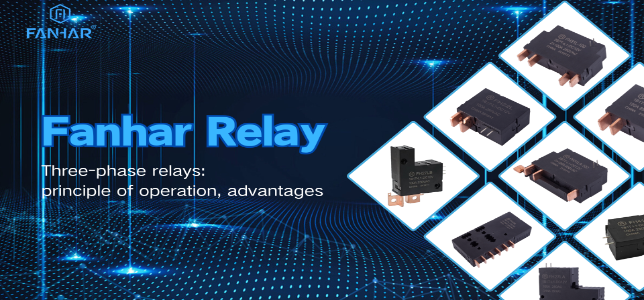
Relays are vital in electrical control systems. They are used to achieve automatic control of electrical equipment through remote control circuits. There are two types of relays: single-phase and three-phase. They are vital in electrical systems. This paper will compare single-phase and three-phase circuits. It will also cover the working principle and benefits of three-phase relays.
The principle of operation of single-phase relays is based on electromagnetic induction.When the current of a control circuit passes through the coil of a relay, a magnetic field is developed within it. This can either pull or release the contact of the relay, thereby changing its switching state. Single-phase relays find their applications in many areas. They are employed in the control of electric motors, lights, solenoid valves, and electric furnaces. Applications include household appliances, industrial automation, and traffic signal control.
Three-phase relays add much to the complexity in addition to being designed for characteristic three-phase circuits, including phase sequence control and the handling of unbalanced loads. In addition to overload protection, three-phase relays may be designed for more advanced protection features, since they can be used in more complex control logic with additional devices. The electromagnetic coil is a major component within a three-phase relay. This means that passing current through the coil creates a magnetic field. This applies a force to the relay's contacts, closing or opening them. Three-phase relays usually have overload protection. It causes the thermal relay to expand when the equipment is overloaded. This momentarily opens the contacts, cutting off the power supply for protection.
Single-phase relays are characterised by small size, light weight, reliable operation and easy installation. Single-phase relays are advantageous in small-scale applications due to their simplicity and cost-effectiveness, but when faced with large or complex three-phase loads, the performance advantages of three-phase relays are even more obvious.
Three-phase relays offer greater reliability and efficiency than single-phase relays and are more widely used in larger systems, especially in industrial motor control and commercial building power distribution. Effective use of three-phase relays can increase productivity, reduce maintenance costs and ensure stable operation of industrial equipment. Three-phase relays are widely used in a variety of applications that require control and protection of three-phase circuits, such as motor start/stop control, lighting system control, fan control, and so on.
The protection functions of single-phase relays are relatively simple. Three-phase relays have more complex protection mechanisms, including overload protection and phase protection. These functions monitor the status of the system in real time and respond quickly when an abnormality is detected, preventing system failure and damage. Phase protection relays provide additional safety by monitoring the current and voltage phases in the circuit to ensure that the system is operating in the correct phase conditions.
In addition to the protection function, the three-phase relay also has control functions, which can start, stop and switch the three-phase power system, and realise the automatic control and remote control of the equipment
Single-phase relays are for single-phase circuits. They control lower power loads, like household appliances, lighting, and small motors. Single-phase relays are also common in HVAC systems in residential and commercial buildings, security systems, and some simple industrial control applications.
Three-phase relays are widely used where three-phase circuits need to be controlled, which includes industrial production lines, motor control systems, and air conditioning systems. Three-phase relays are capable of handling greater power and more complex control logic, such as as being used as protection devices in electrical systems to detect if the voltage falls below a set value and to protect electrical equipment by opening or closing circuits. In addition, three-phase relays are also used for motor protection, as overload protection devices, and in lift control systems to monitor whether the voltage is constant and thus control the operation of the lift.
When selecting a single-phase or three-phase relay, there are several key factors to consider:
Load capacity: Select the appropriate relay according to the size and characteristics of the load. Single-phase relays are suitable for small loads, while three-phase relays are designed to withstand larger loads.
Protection needs: Consider the protection needs of the circuit. Three-phase relays often include overload protection, which protects equipment from damage by shutting off power when the current exceeds a set value.
Cost-effectiveness: Evaluate the balance between cost and performance. Single-phase relays are cheaper. They suit cost-sensitive uses. Three-phase relays are pricier. But, they are better for high-reliability, complex-control apps.
Technical specifications: Consider the technical specifications of the relay, such as rated input voltage, frequency range, output method, etc., to ensure that they meet the requirements of the particular application.
Environmental conditions: Consider the environmental conditions in which the relay will be installed, such as temperature, humidity and vibration, and select a relay that is suitable for these conditions.
Mounting method: Select relays based on mounting space and convenience. For example, some three-phase relays support 35mm DIN rail mounting, which facilitates quick installation and integration.
Certifications and standards: Ensure that the relay complies with relevant safety and performance standards, such as CE, UL, CSA and other approvals
When considering the choice between single-phase and three-phase relays, the key is to evaluate the load demand, protection requirements and cost-effectiveness. For three-phase applications, our FH26L, 29L, 29LA three-phase relays offer efficient solutions for a wide range of industrial and commercial environments. For more information, please contact us for detailed technical specifications and application guidance.